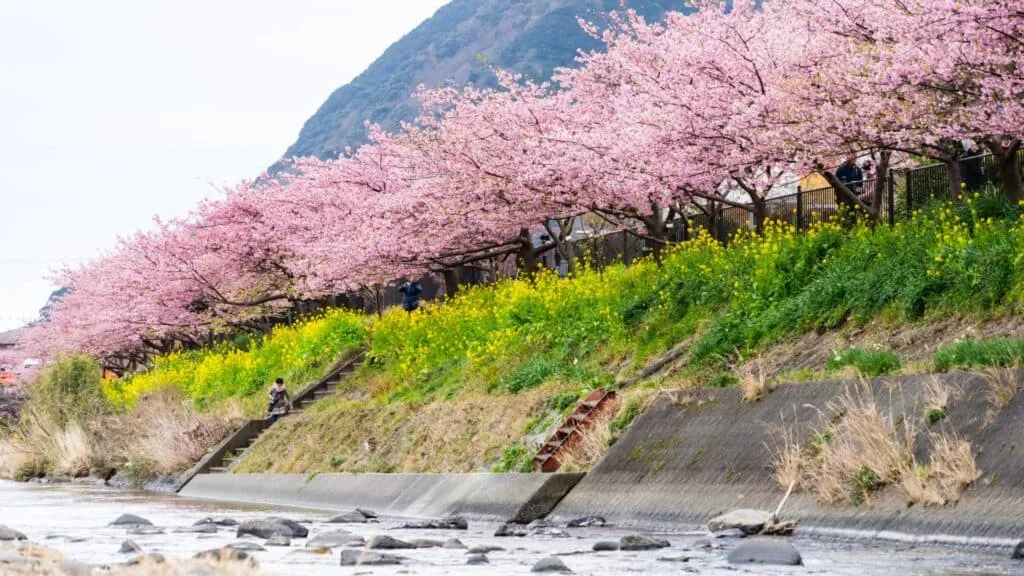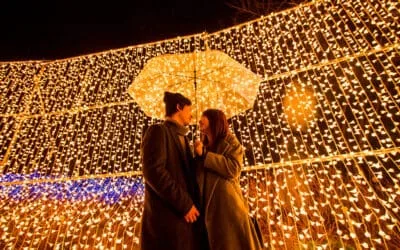February in Japan blends the beauty of snowy landscapes, heartwarming traditions, and mouthwatering winter food. It’s the kind of month where you can dive into snow-filled adventures up north or get a sneak peek of spring with blooming flowers further south. Whether you’re marvelling at glittering ice festivals, soaking in a steaming onsen, or enjoying cosy winter meals, February has a bit of everything.
Think of February as Japan’s love letter to both winter and the year ahead. The north stays wrapped in its snowy charm, perfect for skiing or just admiring the breathtaking landscapes, while southern areas like Shizuoka start hinting at spring with early-blooming cherry blossoms. Add in a few fun festivals, Valentine’s Day treats, and plenty of hot, hearty food, and you’ve got a month that’s a mix of cosy and exciting.
And the best part? Fewer tourists. After the rush of New Year’s celebrations in January, February is a quieter time to explore. It’s great for travellers who want to slow down, soak up some unique traditions, and really enjoy what Japan has to offer during this special season. Whether you’re looking for a snow-filled getaway or a peaceful pre-spring retreat, February will surprise you with its variety.
February in Japan’s Winter Events and Celebrations
Setsubun: Saying Goodbye to Winter

The month kicks off with Setsubun, a fun and slightly quirky tradition that’s all about driving away bad vibes and welcoming good luck. Families and communities come together to toss roasted soybeans at someone dressed as an oni (demon), shouting, “Oni wa soto! Fuku wa uchi!” (“Out with the demons! In with good fortune!”). It’s loud, it’s playful, and it’s perfect for letting loose while keeping tradition alive.
At temples and shrines, the festivities take on an even bigger scale. Performers in vibrant demon costumes roam the grounds, bringing a lively energy to the event. Lucky beans, often beautifully packaged, are handed out to visitors to take home or toss during the celebrations. Some temples even invite local celebrities or sumo wrestlers to participate in the bean-throwing, making it an exciting spectacle to watch.
A big part of Setsubun is the tradition of eating ehomaki, a special sushi roll packed with ingredients like tamago (sweet egg), cucumber, shiitake mushrooms, and sometimes seafood. The roll is eaten in complete silence while facing the year’s lucky direction, believed to bring good fortune. Many convenience stores and sushi shops offer these rolls in colourful packaging during the season, making them easy to grab if you’re travelling.
If you’re visiting Kyoto, the Setsubun celebrations at Yasaka Shrine are particularly famous. Here, you can enjoy traditional performances and soak up the festive atmosphere, complete with food stalls selling seasonal treats like warm sweet sake and mochi. It’s a delightful way to experience the cultural richness of this unique festival.
Valentine’s Day, Japan-Style
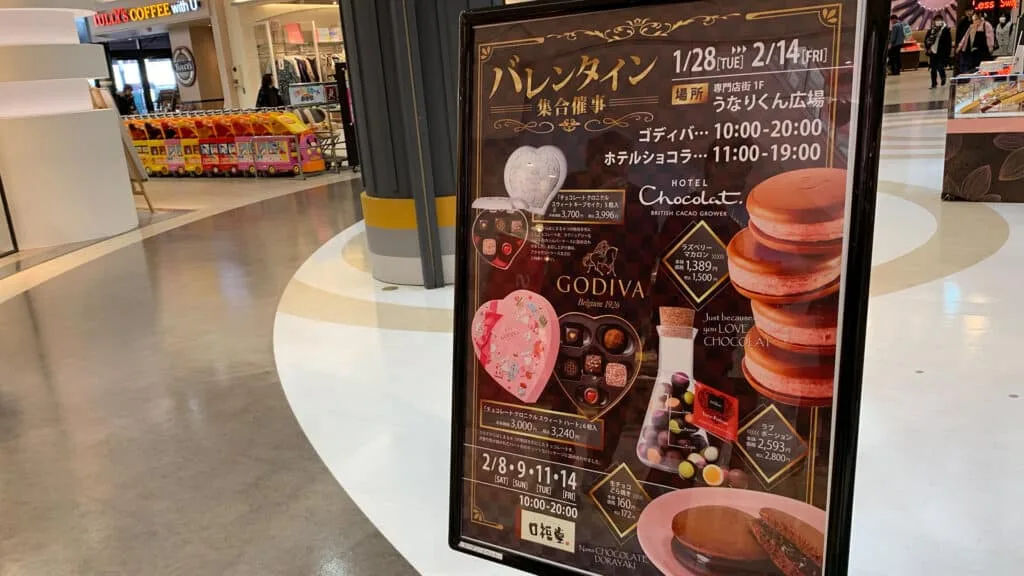
Chocolate fans, rejoice—Japan’s Valentine’s Day is a sugary dream. But here’s the twist: it’s women who gift chocolates to men. There’s giri-choco for friends and coworkers (obligation chocolates) and honmei-choco for someone special (love chocolates). The thought behind the gift matters just as much as the chocolate itself.
Shops go all out, too. You’ll find limited-edition sweets with flavours like matcha and sakura, plus extravagant creations that are almost too pretty to eat. For travellers, it’s a great excuse to sample some of Japan’s best chocolates and maybe even join the tradition by giving or receiving a treat yourself.
Pop-up chocolate fairs and department stores dedicate entire sections to the occasion, offering everything from affordable treats to luxurious handcrafted bonbons.
Another charming aspect of Valentine’s Day in Japan is how much creativity goes into handmade chocolates. Many women take pride in crafting their own unique sweets for loved ones, often decorating them with intricate designs or personal touches.
For tourists interested in joining the fun, workshops for making Valentine’s chocolates can be found in larger cities like Tokyo and Osaka during this time of year.
Valentine’s doesn’t end on the 14th either! The tradition continues into March with White Day, where men return the favour with gifts for the women who gave them chocolates. This extended celebration of affection adds an extra layer of fun to Japan’s unique take on the holiday.
Winter Adventures: Snowy Landscapes and Activities
Sapporo Snow Festival: Ice and Snow Magic

The Sapporo Snow Festival in Hokkaido is one of Japan’s winter highlights, and February is the perfect time to see it. Massive snow and ice sculptures fill Odori Park, ranging from famous landmarks to whimsical creatures. At night, the lights turn the sculptures into glowing masterpieces, creating a magical atmosphere.
The festival is spread across multiple venues. At Tsudome, you’ll find family-friendly activities like snow slides and snow mazes, while Susukino has intricate ice sculptures and ice bars where you can sip drinks in frosty glasses.
Don’t miss out on local food stalls serving steaming bowls of Hokkaido’s famous miso ramen or grilled seafood skewers—the perfect way to warm up as you explore.
For those wanting a full-day experience, you can take guided tours that cover all three main sites of the festival. These tours often include insider stories about the sculpting process and behind-the-scenes glimpses of how the giant snow art comes together. And for the adventurous, snowmobiling tours in nearby areas add an extra thrill to your Sapporo trip.
Skiing and Snowboarding: Perfect Powder

February’s snow is no joke, and Japan’s ski resorts are still going strong. Hokkaido’s Niseko and Furano are legendary for their fluffy powder, while Nagano’s Hakuba Valley is a favourite for its variety of slopes. Even beginners will find it easy to get started, with lessons and friendly slopes everywhere.
If skiing isn’t your thing, many resorts offer other snow activities like snowshoeing, sledding, or just enjoying the scenery. For adrenaline seekers, backcountry skiing in places like Asahidake is an epic adventure. And after a day on the slopes, there’s nothing better than sinking into a hot spring or enjoying a feast of hearty local dishes at a ski lodge.
Onsen Escapes: Snow and Steam

Picture this: you’re soaking in a hot spring, surrounded by snow-covered trees, with steam rising all around you. That’s the magic of a winter onsen. Kusatsu Onsen in Gunma and Gero Onsen in Gifu are just two of the many famous spots to check out.
Nyuto Onsen in Akita offers a truly special experience with its open-air baths surrounded by snowy forests. For a romantic touch, book a private onsen bath with a view of the snow. The contrast of the icy air and the warm water is unforgettable, making it a must-try for anyone visiting Japan in winter.
February Cuisine: Warming Winter Fare and Seasonal Treats
Nabe: The King of Winter Food

If there’s one meal that screams winter comfort, it’s nabe. This hot pot dish is all about gathering around a bubbling pot filled with fresh veggies, tofu, seafood, or meat. There are endless variations depending on where you are in Japan. Hokkaido’s kani nabe (crab hot pot) is packed with sweet, tender crab, while Kyushu’s motsunabe (offal hot pot) has a rich, savoury flavour.
What makes nabe special isn’t just the taste. It’s the experience of sitting with friends or family, sharing a meal straight from the pot. Many restaurants specialise in nabe, offering unique regional broths and toppings. Pair it with a glass of sake, and you’ve got the ultimate winter dinner.
Strawberries: Sweet and Juicy
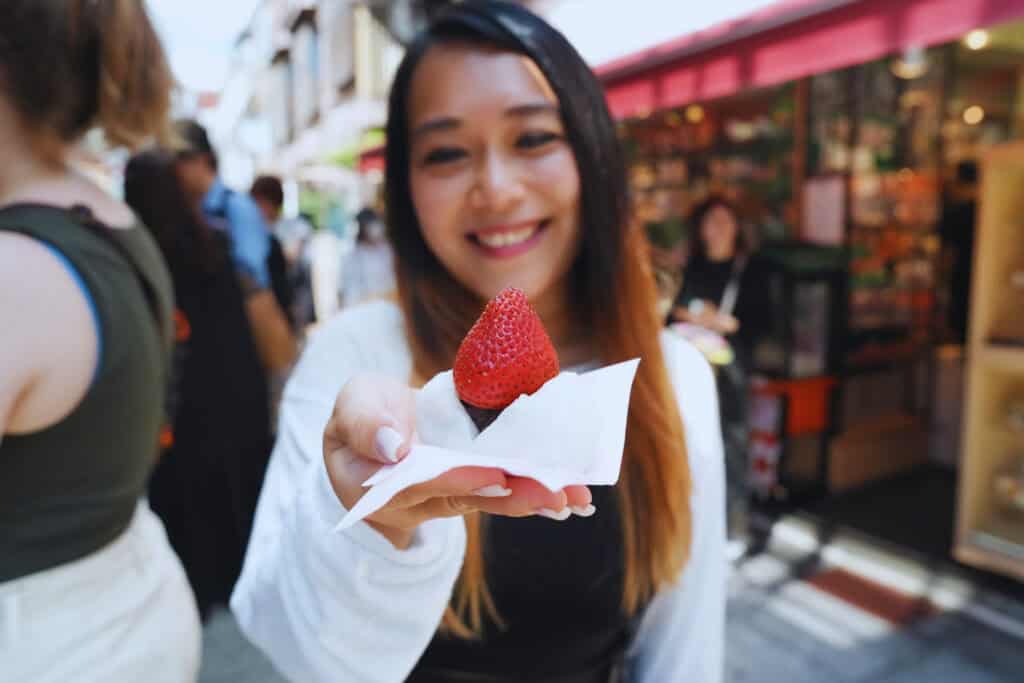
February is peak strawberry season, and Japan’s strawberries are next-level good. From strawberry daifuku (mochi stuffed with red bean paste and a fresh strawberry) to towering parfaits loaded with berries, there’s no shortage of ways to enjoy this seasonal treat.
Strawberry farms in places like Shizuoka and Fukuoka let you pick and eat your own strawberries. It’s a fun activity for all ages, and nothing beats the taste of a fresh, perfectly ripe berry. Many cafes also offer seasonal desserts like strawberry shortcake or pancakes topped with whipped cream and berries.
Valentine’s Chocolate and Beyond

With Valentine’s Day in full swing, chocolate takes centre stage in February. Pop-up shops and bakeries go all out with creative treats, like yuzu-flavoured truffles or sakura-shaped chocolates. Even if you’re not big on Valentine’s, it’s the perfect excuse to indulge in some of Japan’s best sweets.
February Weather in Japan: What to Expect

Hokkaido: Snowy Wonderland
Hokkaido stays deep in winter, with temperatures between -10°C and -1°C. Snow blankets the region, making it a paradise for skiers and anyone who loves a classic winter landscape. Don’t forget your thermals and snow boots!
Tohoku: Quiet and Cosy
In northern Honshu, Tohoku is all about serene, snowy views and cosy hot springs. Temperatures range from -5°C to 5°C, so it’s chilly but not unbearable. A visit to Ginzan Onsen, with its lantern-lit streets, is like stepping into a winter dream.
Tokyo and Kyoto: Clear and Cool
Central Japan’s February weather is crisp and dry, with Tokyo averaging 2°C to 10°C. Kyoto is a bit milder, and both cities enjoy clear skies perfect for sightseeing. If you’re lucky, you might even catch a rare snowfall.
Okinawa: Mild and Relaxing
For a completely different vibe, Okinawa offers 15°C to 20°C temperatures and a subtropical escape. It’s a nice break from the cold if you’re craving a little warmth.
Seasonal Highlights: February Festivals and Events
Snow Festivals Big and Small
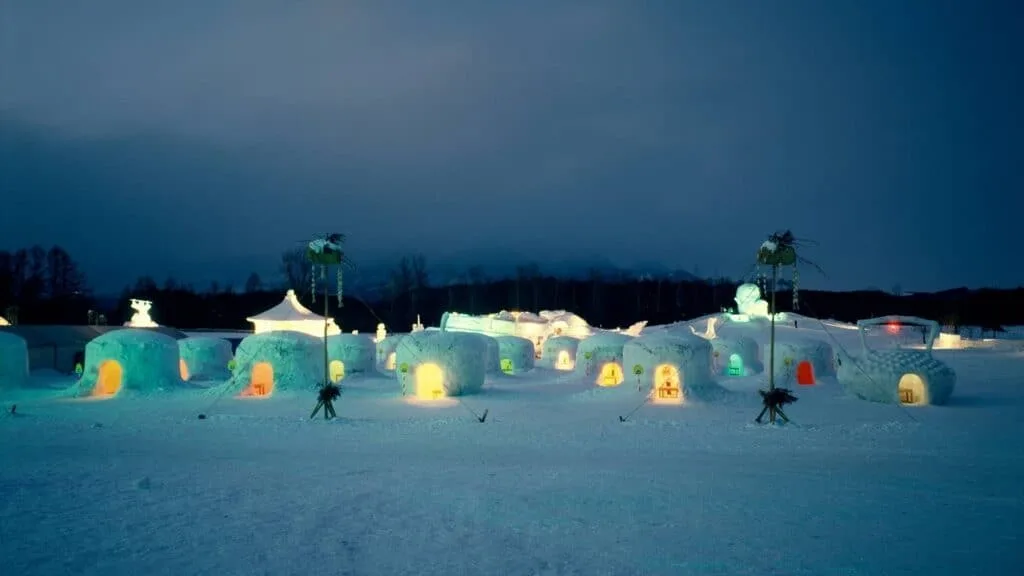
The Sapporo Snow Festival is undoubtedly the star of Japan’s winter festivities, drawing visitors from across the globe to see its incredible ice and snow sculptures. Held over several days in Hokkaido’s capital, this festival is more than just a showcase of artistry. It’s a vibrant celebration where the entire city comes alive with events, food stalls, and activities.
Visitors can marvel at gigantic sculptures that depict everything from iconic landmarks to whimsical fantasy scenes, illuminated beautifully at night. Live performances, snow slides, and interactive exhibits make it an engaging experience for families, couples, and solo travellers alike.
But Sapporo isn’t the only winter wonderland worth exploring. In nearby Otaru, the Snow Light Path Festival offers an entirely different vibe. Picture this: a quiet canal lined with glowing lanterns, snow softly falling, and a magical atmosphere that feels almost like stepping into a dream.
It’s romantic and serene, perfect for a peaceful evening stroll or capturing stunning photos. Small snow statues and candles scattered around the city add to the charm, making Otaru a must-visit for anyone seeking a more intimate winter festival experience.
Further south, the Tokamachi Snow Festival in Niigata blends tradition and fun in an unforgettable way. This festival showcases impressive snow sculptures alongside cultural performances, live music, and even fireworks. One highlight is the Snow Carnival, where performers put on energetic shows on snowy stages.
Visitors can also enjoy snow rafting, sledding, and indulging in warm local dishes like nabe and grilled seafood. It’s a festive and lively event that brings the community together, offering a more local take on winter celebrations.
Kawazu Sakura: Spring Comes Early
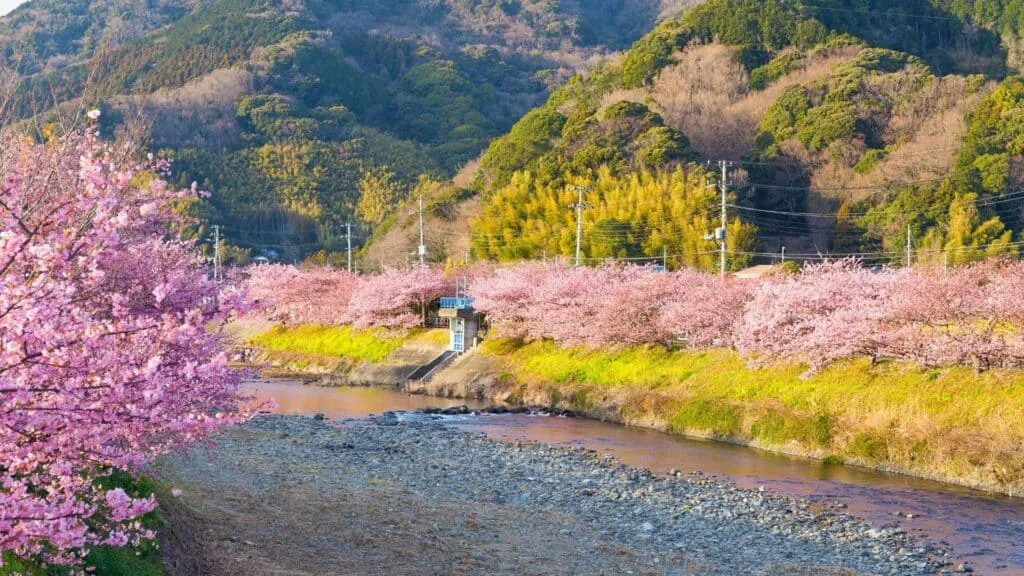
February offers a sneak peek of spring in Shizuoka, where the Kawazu cherry blossoms start to bloom much earlier than their counterparts across Japan.
These stunning bright pink flowers, known as Kawazu sakura, line the banks of the Kawazu River, creating a scene so picturesque it feels like stepping into a postcard. Unlike typical cherry blossoms, which bloom for only a week or two, Kawazu sakura last for about a month, giving visitors plenty of time to soak in their beauty.
The annual Kawazu Cherry Blossom Festival takes this natural wonder to the next level. The riverbanks are decorated with food stalls selling sakura-themed snacks and local delicacies like freshly grilled seafood and pink sakura mochi. At night, the blossoms are illuminated, casting a romantic glow over the water that’s perfect for evening strolls or date nights. The festival atmosphere, combined with the breathtaking views, makes this a must-visit spot for anyone eager to experience Japan’s famous cherry blossoms a little earlier than usual.
For those looking to make a day of it, the surrounding area offers hot springs, quaint cafes, and scenic hiking trails.
Plum Blossoms: Pretty and Peaceful
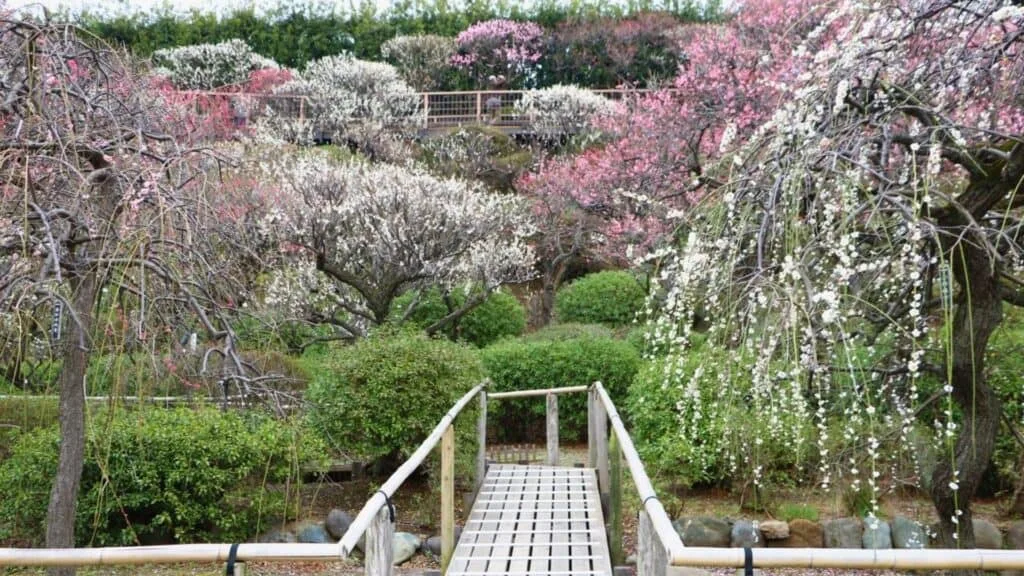
While cherry blossoms steal the spotlight in spring, February belongs to the understated beauty of plum blossoms, or ume. These delicate flowers bloom in soft shades of pink, white, and sometimes yellow, offering a tranquil and less crowded alternative to sakura season.
Unlike the fleeting nature of cherry blossoms, plum blossoms tend to last longer, allowing visitors to enjoy their beauty over several weeks.
One of the best places to experience plum blossoms is Kairakuen in Ibaraki Prefecture, considered one of Japan’s top three gardens. Here, over 3,000 plum trees create a stunning display that stretches across the park.
The garden’s layout, designed to provide both aesthetic pleasure and peaceful strolling paths, is particularly enchanting during the blooming season. Visitors can sip on hot plum tea, enjoy traditional sweets, and even catch cultural performances that celebrate the season.
In Kyoto, Kitano Tenmangu Shrine is another must-visit spot for plum blossom lovers. Known for its ties to scholars and students, the shrine features a lovely grove of ume trees that come alive with colour in February.
The annual Plum Blossom Festival at the shrine includes tea ceremonies served by maiko (apprentice geisha), making the experience uniquely Kyoto. Strolling under the fragrant blossoms while enjoying the shrine’s historic charm is a perfect way to embrace the quieter side of Japan’s early spring.
Fall in Love with the Month of Love in Japan

February in Japan is one of those months where you can truly experience the country’s dual personality. On one hand, you’ve got the last glorious hurrah of winter: snow-covered mountains, steaming hot springs, and cosy nabe dinners with friends. On the other hand, hints of spring begin to emerge, with early cherry blossoms like the Kawazu sakura painting the landscape in delicate pinks. It’s the perfect blend of seasons, giving you a taste of both without the peak tourist crowds.
If you’re someone who loves snowy adventures, February is a goldmine. Whether it’s skiing in Hokkaido’s world-famous resorts or just wandering through a snow festival surrounded by glittering sculptures, there’s no shortage of frosty fun.
And even if you’re not a fan of winter sports, soaking in an onsen while snowflakes gently fall around you is an experience you’ll never forget. Don’t miss out on the snow monkeys of Nagano either; watching them relax in natural hot springs is like seeing nature’s own spa session.
For those who crave a slower pace, February’s calm atmosphere is unbeatable. Imagine walking along the banks of the Kawazu River, lined with early-blooming sakura trees, while munching on sakura-flavoured snacks from nearby stalls. Or visiting a historic shrine like Kitano Tenmangu to enjoy the subtle beauty of plum blossoms, away from the typical springtime crowds. February feels like a secret that only those in the know get to enjoy.

